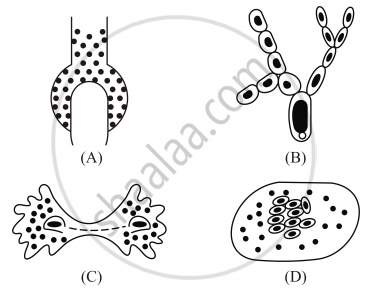Advertisements
Advertisements
Question
Two very small organisms X and Y both reproduce by the method of budding. Organism X is industrially very important because it is used in making alcohol from sugar. It is also used in making bread. Organism Y Lives in freshwater. If organism Y gets cut into a number of parts accidently, each cut part can grow to form complete organism.
(a) What are organisms X and Y?
(b) What is the name of the process in which X converts sugar into alcohol?
(c) To which class of organisms does X belong?
(d) Name an important body feature of organism Y.
(e) Which organism is multicellular and which one is unicellular?
Solution
(a) The organism X is yeast and organism Y is Hydra.
(b) The process by which the organism X converts sugar into alcohol is fermentation.
(c) Organism X is a fungus; hence, it belongs to the category of non-green plants.
(d) Organism Y is a multicellular organism and comprises tentacles at one end.
(e) Organism X is unicellular, and the organism Y is multicellular.
APPEARS IN
RELATED QUESTIONS
How will an organism be benefited if it reproduces through spores?
Describe the grafting method for the artificial propagation of plants with the help of labelled diagrams.
The thread like structures that develop on a moist slice of bread in Rhizopus are ______.
There are four tiny organisms A, B, C and D. The organism A is a parasitic protozoan which causes a disease known as kala-azar. The organism B is a microscopic single-celled animal which causes malaria disease in human beings. The organism C is a unicellular animal which can change its body shape according to need, it has no fixed shape. The organism D is also a unicellular animal which is slipper-shaped having a large number of tiny hair all around its body.
(a) Name the organisms A, B, C and D
(b) Name one characteristic body feature of organism A.
(c) Name the insect which carries organism B and transmits it from one person to another.
(d) What name is given to the asexual method of reproduction of (i) organism A, and (ii) organism B?
(e) Where do organisms C and D live?
Explain the process of binary fission in bacteria.
A student after observing a slide showing different stages of binary fission in Amoeba draws the following diagrams. However these diagrams are not in proper sequence:
The correct sequence is:
(A) I, V, IV, III, II
(B) I, III, IV, V, II
(C) I, V, III, IV, II
(D) I, IV, V, III, II
Binary fission is observed in which one of the following figures?

Why is chemical communication better than electrical impulses as a means of communication between cells in a multi-cellular organism?
Why anther is called as tetrasporangiate structure?
Which of the following methods of asexual reproduction are observed in lower organisms?
